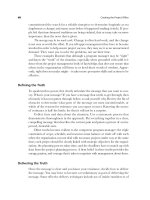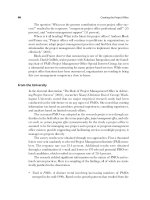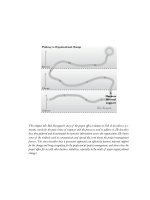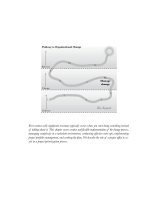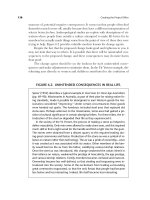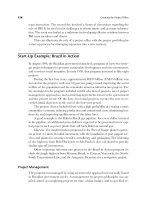Tài liệu Creating the project office 21 docx
Bạn đang xem bản rút gọn của tài liệu. Xem và tải ngay bản đầy đủ của tài liệu tại đây (83.75 KB, 10 trang )
Stage 3: Fully Functional.
The main objective for this stage was automation of
all activities. Elapsed time for this stage was four months.
All initial activities needed to be more effective, adding value to project man-
agers and also to an achievement-driven organization. Measurements included
achievements defined and assigned for accountability, automated and imple-
mented assignments, templates created and being used. Major processes must have
automated trend analysis conducted and mentoring in place, and 70 percent to
80 percent of all projects must have a project plan and activity duration derived
from historical data.
Stage 4: Continuous Improvement.
This stage is in process as we write. They es-
timate an elapsed time of eight months.
They employed their standard quality assurance system. They updated soft-
ware tools according to PMO user needs and tuned the success measures. They
planned key areas to improve such as project numbering, tracking of project suc-
cess, decreasing the number of failed projects, and increasing the number of pro-
fessional project managers on staff. They expect 90 percent of all projects to have
a project plan.
Quality Assurance
Project office employees need many skills to perform quality assurance within each
project. A wide range of methodologies, software applications, procedures, tools,
and templates are employed. Because project office employees all work on multi-
ple projects, knowledge and experience with methodologies, software applications,
procedures, tools, and templates builds up faster than it does with project man-
agers on single projects. The reason to make the project office responsible for qual-
ity assurance is that improvements can be implemented and communicated faster
than when the task is left to the individual projects.
The project manager is responsible for the overall project delivery process.
Project office employees are not expected to know the project technical content.
Standardized project planning and frequent project delivery process experiences
are two aspects that give the project management team a standardized quality im-
provement process. Knowledge sharing is a major factor for both those aspects.
Figure 7.4 shows the quality cycle. This is a proposed model combining
strengths that the project office has proven. Quarterly they ran a PMO customer
survey to check the satisfaction level of PMO users (project managers and con-
sultants). During the first quarter participation was low (25 percent), but more
people participated and provided feedback about the usability of PMO services,
which allowed them to improve their service level.
178 Creating the Project Office
The PMO surveys cover these areas of customer satisfaction:
• General PMO perception
• PMO Services provided (deliverables)
• Response time
• PMO—project manager relationship
• Web services availability
Also the management team used the results of the PMO surveys to encourage
people to use the PMO. Figure 7.5 shows a graphic example of a survey response.
Stakeholder Analysis
The HPC project office stakeholders were the managers of the businesses and so-
lutions that influence end users and upper managers alike. A stakeholder analy-
sis helped Bucero understand the way different individuals influence decisions
throughout the project.
He used a process based on asking four basic questions and brainstorming
for answers:
• Who are the stakeholders?
Identify all possible stakeholders.
Identify where each stakeholder is located.
Identify the project team’s relationship with each stakeholder in terms of
power and influence during the project life cycle.
Implementing the Project Office 179
FIGURE 7.4. STANDARDIZED QUALITY IMPROVEMENT PROCESS.
Knowledge sharing
and continuous
improvement
Quality
assurance
Relieve
PM
activities
Project
delivery
process
Plan Do Check Act
• What are stakeholder expectations?
Identify primary high-level project expectations for each stakeholder.
• How does the project or product affect stakeholders?
Analyze how the products and deliverables affect each stakeholder.
Determine what actions the stakeholder could take that would affect the suc-
cess or failure of the project.
Prioritize the stakeholders, based on who could have the most impact on
project success or failure.
Incorporate information from earlier steps into a risk analysis plan to develop
mitigation procedures for stakeholders who might be disposed to harm the
project.
• What information do stakeholders need?
Identify what information needs to be furnished to each stakeholder, when
should it be provided, and how. The answers to the first three questions
should provide a basis for this analysis.
The stakeholder analysis is fundamental to PMO project success. Bucero uses
the type of map illustrated in Figure 7.6 to keep track of all political issues dur-
ing the project office project life cycle. For example, “One political issue that I ob-
served using the map was a middle manager who had a lower level of concern
180 Creating the Project Office
FIGURE 7.5. SURVEY OF PMO USAGE.
0
General
4.2
4.1
4.5
4.3
3.3
4.1
Delivery Response
Time
PM
Relationship
Web Total
1
2
3
4
5
regarding the project office implementation. I then prepared a communication
plan to address that issue.”
That plan reflected actions such as these:
• Face-to-face meetings with each middle manager, explaining the PMO mission
and objectives, and most important, getting them to share their expectations
from the PMO. These meetings helped Bucero understand their real needs and
expectations.
• Brainstorming sessions with all middle managers, using mind-mapping tech-
niques. These sessions helped brainstorm ideas, suggestions, and real needs
from various perspectives, which helped develop a more aligned vision for the
PMO.
• Identifying barriers such as organizational climate, perceptions, customer pres-
sure, too many communication links, and too many projects, and working to
avoid or minimize them by talking with the middle managers.
Implementing the Project Office 181
FIGURE 7.6. A STAKEHOLDER MAP, EACH BUBBLE A KEY PERSON.
High
Power
Low
Low High
Level of Concern
Support and Sponsorship
The stakeholder analysis tool helped get more support from the management
team through business needs identification. The PMO program manager acts as
facilitator, promoting, managing, encouraging, and optimizing relations among
all stakeholders.
Here are a few of the things the program manager did to achieve sponsor
support:
• Explaining and validating the PMO mission and objectives periodically
• Keeping management in the loop (sharing real PMO status, problems, and issues)
• Using a PMO selling presentation
• Showing small deliverables very quickly to convince them with tangible facts
• Showing passion, persistence, and patience (different people, different behav-
iors, different culture)
• Offering all services without charge to any solution area, PM, or consultant
Sponsors’ Role
How did sponsors demonstrate support?
They pushed the rest of the organization to use the PMO services and also
use the PMO as an example. They asked the PMO manager to attend manage-
ment meetings to inform them about PMO implementation status and to esca-
late any issue or problem. When managers saw how the PMO was helping the
organization, they began talking outside the organization about the benefits of
using a PMO. For instance, one said, “The PMO is alive because everyone who
asks for a service is given an answer and the PMO team never refuses any de-
mand; they proactively search for solutions.” They recognized the effort of PMO
implementation at the end of the fiscal year, giving a prize to the PMO team dur-
ing the kickoff meeting.
Other Assistance
Who else helped Bucero implement the PMO?
Team members work in an open climate of communication and transparency.
After doing the stakeholder analysis, he identified key players and project man-
agers who could help him sell the advantages and PMO benefits. Those colleagues
were great ambassadors for PMO services and also supported him during the con-
tinuous improvement cycle.
182 Creating the Project Office
